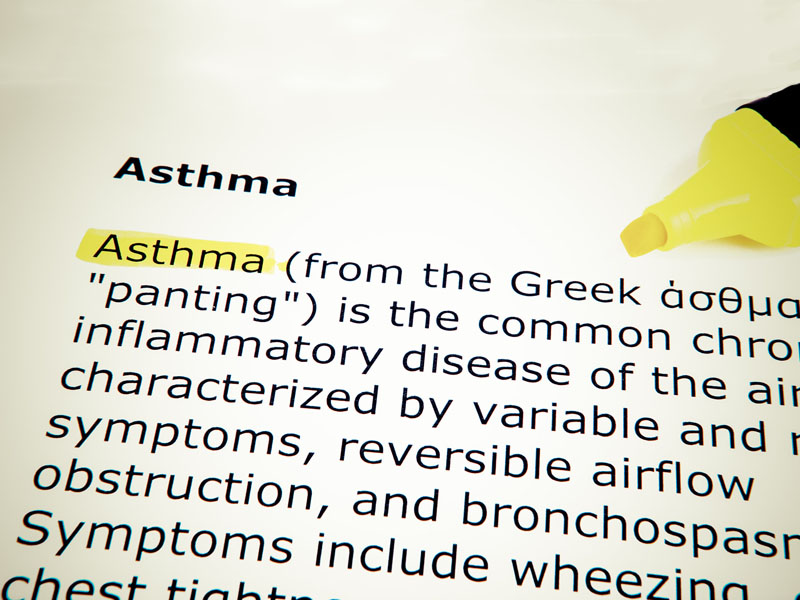AFP Updates Members on Asthma Management
November Issue Features Guideline Summary, Editorial, Call for Feedback
November 18, 2021, 1:15 p.m. News Staff — Last year, the federal government released its first major guideline update on the diagnosis and management of asthma in more than a decade, offering family physicians several dozen pages of new information that allowed for improvements in care and shared decision-making with patients.

A summary of the guideline update has been published in the November issue of American Family Physician. The summary briefly addresses the topics that received focused updates, and is accompanied by an editorial from Kurt Elward, M.D., M.P.H., a family physician member of the National Asthma Education and Prevention Program Coordinating Committee Expert Panel Working Group, that explains how the update differs from recommendations published by the Global Initiative for Asthma.
It should be noted that at this time, these guidelines have not been reviewed by the AAFP.
Updates by Topic
The 2020 guideline update included nearly 20 recommendations focused on six priority topics.
Allergen mitigation. Multicomponent interventions have been shown to reduce asthma exacerbations and improve outcomes such as quality of life, asthma control and symptoms slightly, but these interventions can be expensive and difficult to perform or maintain. Single-component asthma interventions have not been shown to improve outcomes.
Combined approaches that involve integrated pest management of cockroaches and mice, mattress covers and pillow covers for dust mites, high-efficiency particulate air-filtered vacuums and home mold mitigation systems are effective in individuals with asthma who have sensitization or symptoms related to exposure to these allergens. In some individuals, however, cleaning and integrated pest management interventions may transiently worsen asthma symptoms.
Studies are inconclusive as to whether pet removal improves pet-related allergies.
Because of marginal benefits, patient burden and potential costs, allergen mitigation interventions should be considered for patients with symptoms related to identified indoor allergen exposure that has been confirmed via allergy testing or clinical history.
Story Highlights
Bronchial thermoplasty. Although this therapy has been approved for severe persistent asthma, the risks and uncertain long-term outcomes outweigh the small benefits in asthma control. The expert panel conditionally recommends against bronchial thermoplasty in individuals 18 and older with persistent asthma; however, those with persistent asthma who place a low value on harms and a high value on potential benefits may consider the therapy.
Fractional exhaled nitric oxide. Although fractional exhaled nitric oxide testing may be useful if an asthma diagnosis is uncertain, elevated levels may also indicate conditions such as allergic rhinitis, atopy, smoking and chronic lung conditions. Tracking fractional exhaled nitric oxide levels does not improve outcomes or quality of life, and should not be used to assess asthma control or predict future asthma exacerbations.
Immunotherapy. Subcutaneous immunotherapy should be considered if skin testing or in vitro antigen-specific immunoglobulin E testing suggests that allergen exposure worsens asthma control.
Subcutaneous immunotherapy is not recommended for patients with severe asthma because of increased risk of anaphylaxis.
Sublingual immunotherapy is not approved for asthma.
Patients with asthma should not administer immunotherapy at home.
Inhaled corticosteroids. In children up to age 4 years who experience wheezing with respiratory infections (but not between infections), a seven- to 10-day course of daily ICS at the onset of a respiratory infection reduces exacerbations and systemic corticosteroid use.
In children age 4 years and older with moderate to severe persistent asthma, a single inhaler can be used as rescue therapy. In single maintenance and reliever therapy, ICS and formoterol can be used in combination as daily controller therapy and as a rescue inhaler for up to eight puffs daily (in children ages 4 to 11 years) or 12 puffs daily (in patients older than 12 years).
In patients age 12 years and older with mild persistent asthma, use of both ICS and a short-acting beta agonist as rescue therapy is equivalent to daily ICS controller therapy with SABA rescue therapy. However, the benefit of rescue ICS therapy is uncertain in children younger than 12 years.
Long-acting muscarinic antagonists. In patients with uncontrolled asthma despite daily ICS therapy, adding an inhaled long-acting beta-agonist is recommended instead of adding a LAMA, as adding a LAMA has been associated with increased hospitalizations.
In patients for whom LABA is contraindicated or may not be tolerated, adding a LAMA to ICS may be indicated. Adding a LAMA to ICS/LABA therapy does not decrease exacerbation frequency or systemic corticosteroid or rescue medication use.
In addition, LAMA medications should be avoided in patients at risk of urinary retention and glaucoma.
Additional Comments
In the editorial, Elward said the guideline update differed from the Global Initiative for Asthma recommendations in two areas: the number of issues addressed and the nature of the evidence review.
The Global Initiative guidelines, Elward said, pertain to a broad range of asthma topics, whereas the focused updates targeted areas for which there was both strong interest and sufficient evidence to influence patient care. The focused updates also used systematic reviews from the Agency for Healthcare Research and Quality and the Grading of Recommendations Assessment, Development and Evaluation methodology to assess study design and evidence relevance, and paid attention to asthma management from the perspective of primary care.
Elward acknowledged some limits to the focused updates, such as the decision to center immunotherapy recommendations only as they applied to asthma and not other elements of allergy care, and to not address issues such as health care payment and insurance coverage. He encouraged family physicians to email the expert panel to provide feedback on the recommendations and other areas where clinical questions remain.